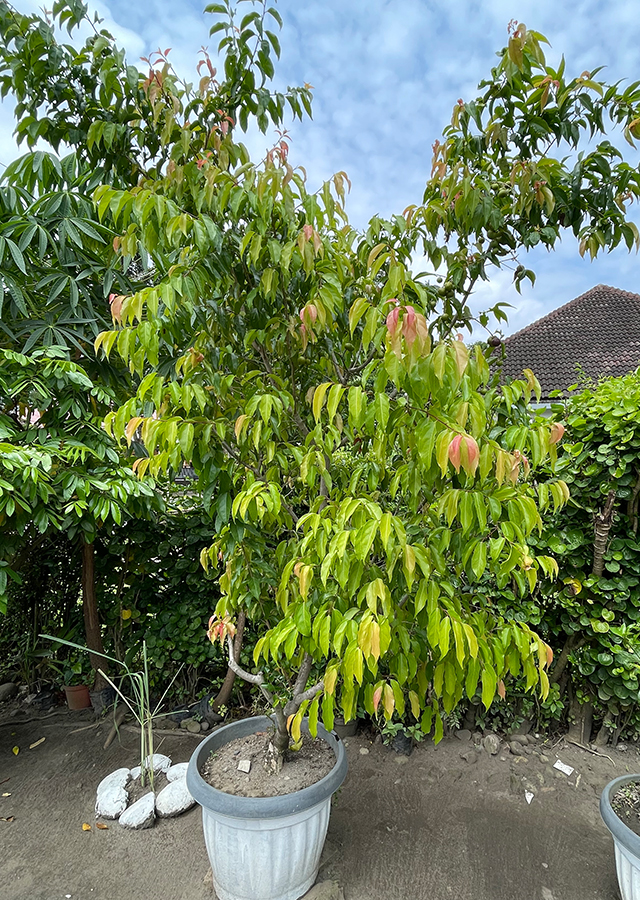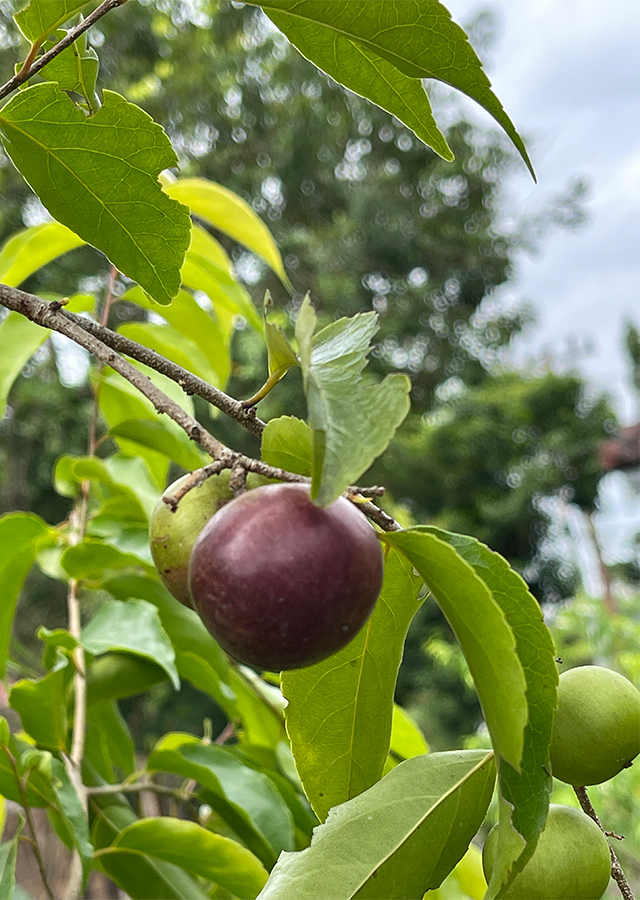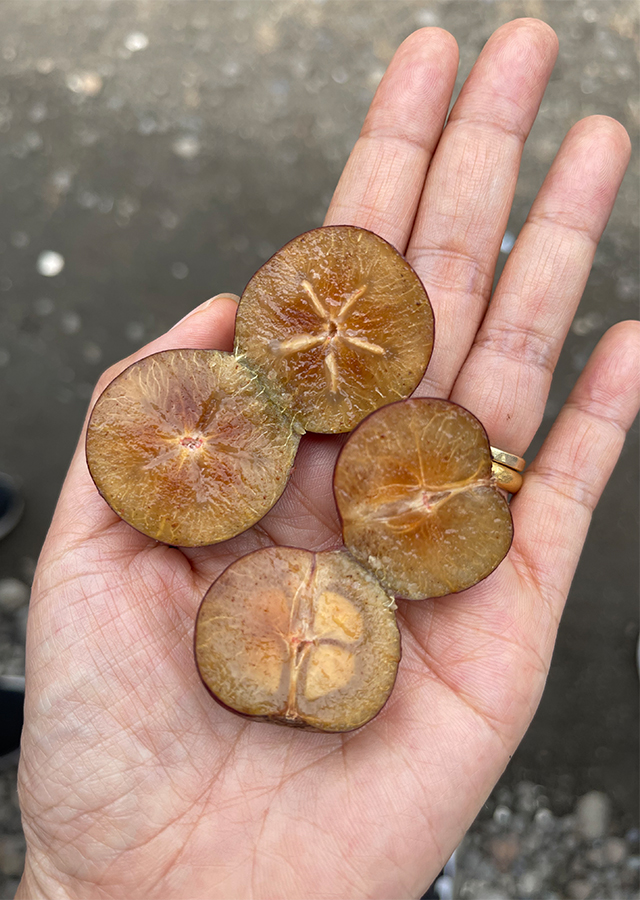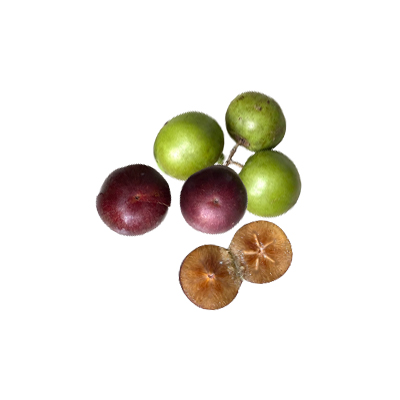Indian Plum
Flacourtia jangomas (Lour.) Raeusch.
Salicaceae
Location in our garden
Orchard



Synonym
Rumea jangomas (Lour.) Spreng.
Stigmarota jangomas Lour.
Flacourtia cataphracta Roxb. ex Willd.
Habitus
Trees. Small tree, annual (perennial), reaching 6-10 m in height, sometimes reaching 14 m.
Part Used
Leaves
Bark
Fruit
Roots
Growing Requirements
Full Sunshine
Habitat
Terrestrial
Overview
Flacourtia jangomas or Indian plum is a plant from the Salicaceae family that is native to Assam, Bangladesh, China, the Eastern Himalayas, Hainan, Myanmar and Nepal. From its place of origin, this type was then introduced to various regions, such as Borneo, Java, Cambodia, Cook Islands, Fiji and India. This plant is generally used as a fruit producing plant, woody plant, ornamental plant, and traditional medicinal ingredient. The use of F. jangomas as a traditional medicine has been used for centuries to treat various human diseases due to the presence of phytochemical compounds that have therapeutic value in it. Ripe fruit that is dark red or purple in color can be eaten raw or used to make jams, juices, syrups, jellies, sauces and sweets. It also has the potential to be developed as a food product that can provide important nutrition for the population. This is especially relevant for developing countries in Southeast Asia where indian plum tree is widely grown naturally and cultivated. However, its use in society is still not optimal, even though this plant has many uses. In fact, trees are often cut down because their economic value is low and replaced with other plants with higher economic value.
Vernacular Names
No data found. Need further research.
Agroecology
It is a tropical lowland plant that is hot and humid. Prefers a position in full sun in fertile, well-drained soil.
Morphology
- Stems - and younger tree branches generally have spines that gradually disappear as the tree ages. The bark is light brown to coppery red or pink. Young branches have white spots due to the presence of many circular lenticels.
- Leaves - arranged alternately, stemmed, deciduous. The leaves are elliptical, oval or lanceolate, rounded base, pointed tip, serrated edge. The upper surface of the leaves is shiny dark green, the underside is shiny light green. Young leaves are pink. Leaves measure 7.0-11.0 cm long and 3.5-4.0 cm wide.
- Flowers - appear in the leaf axils, bunch shaped, glabrous. Male and female flowers are on separate trees. Male flowers are solitary or clustered, filamentous and glabrous; while the female flowers are solitary only. The flower petals are 4 or 5 in number, oval-triangular in shape carrying a honey aroma. Flowers are white to greenish.
- Fruits - The berries are elliptical to slightly round with a diameter of 1.5-2.5 cm. The fruit is green, then turns red-brown or dark purple, then becomes black when ripe. The flesh is greenish yellow, the taste is sweet, slightly astringent.
- Seeds - flat, numbering 4-5, sometimes up to 10 seeds.
Cultivation
Generally propagated using seeds. However, without any treatment before sowing, the seeds germinate rather slowly due to the hard condition of the seed coat. Soaking seeds in cold water at room temperature for 24-48 hours can also increase germination capacity and germinate within 25-29 days after sowing. Soaking seeds can also be done in hot water (60-70 °C) for 5 minutes, then soaking them in water with room temperature for 5 minutes can produce higher germination power than using cold water at room temperature.
Chemical Constituents
Alkaloids, glycosides, steroids, flavonoids, essential amino acids, phenols, tannins, terpenoids, saponins, coumarins (ostruthin), and isocoumarins.
Traditional Medicinal Uses
- Treats toothache, bleeding gums, diabetes.
- Soothes an inflamed throat
- Treats coughs, fever, stomach ache, indigestion, diarrhea, dysentery, hemorrhoids, asthma, bronchitis, anemia, liver-related disorders, jaundice, wounds, boils, herpes infections.
- Relieves hoarseness, thirst and nausea.
- Has antibacterial, antifungal, diuretic, astringent, analgesic, antioxidant, anti-inflammatory properties.
Part Used
Reference Sources
- Royal Botanic Garden, Kew. Plants of the World Online. Flacourtia jangomas (Lour.) Raeusch.. Flacourtia jangomas (Lour.) Raeusch. | Plants of the World Online | Kew Science. 17-10-2023.
- Handayani, T. 2021. POTENSI DAN NUTRISI RUKAM MANIS (Flacourtia jangomas (Lour.) Raeush). Warta Kebun Raya 19 (2), November 2021.
- Rai, A., Mishra T. 2020. ETHNOMEDICINALAND THERAPEUTIC VALUES OF FLACOURTIA JANGOMAS. The Journal of Indian Botanical Society, Vol. 100 (3&4) 2020:42-52. DOI: 10.5958/2455-7218.2020.00037.6.
- Tropical Plants Database, Ken Fern. 2022. Flacourtia jangomas. Flacourtia jangomas - Useful Tropical Plants (theferns.info). 17-10-2023.



